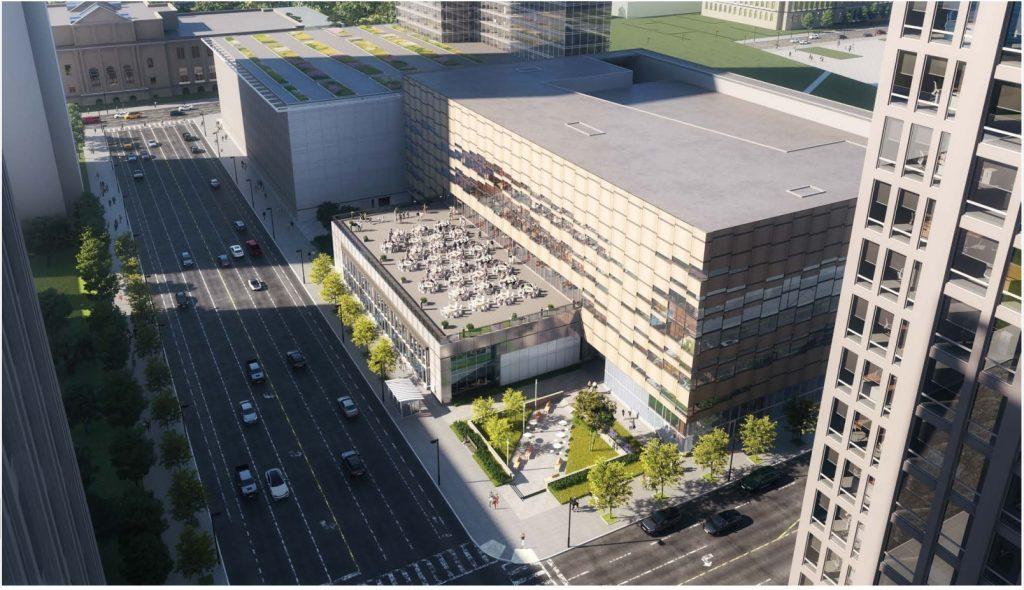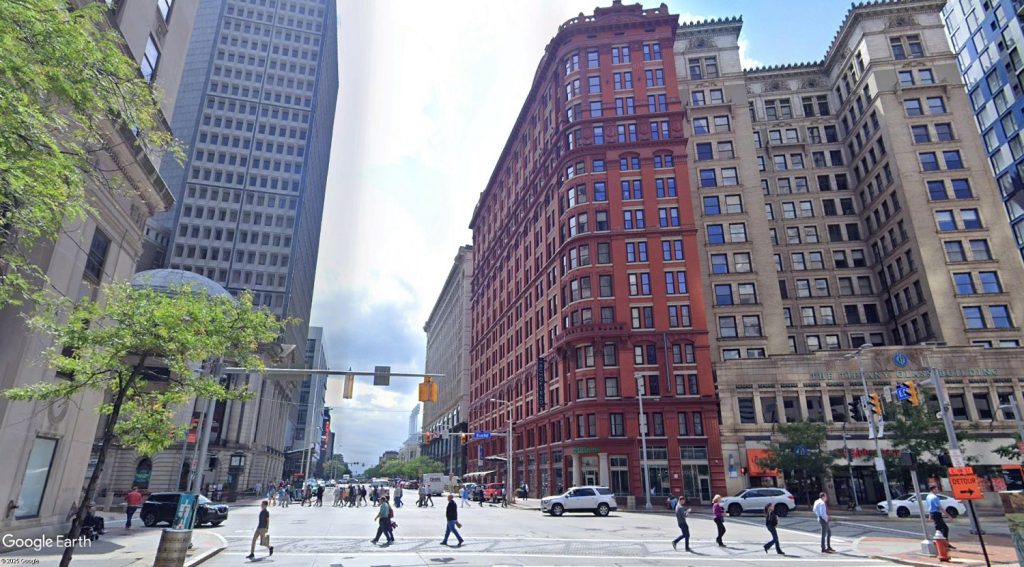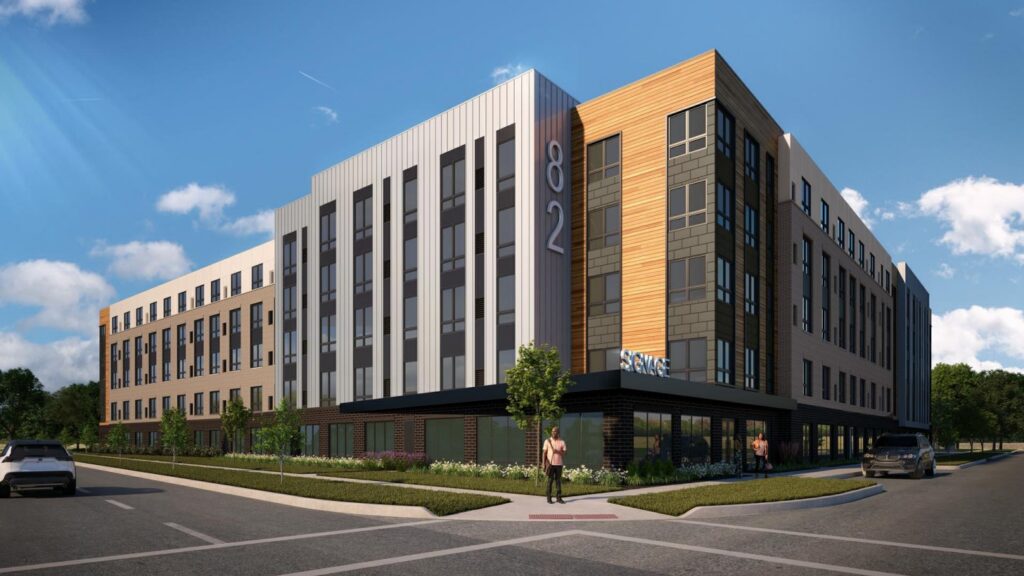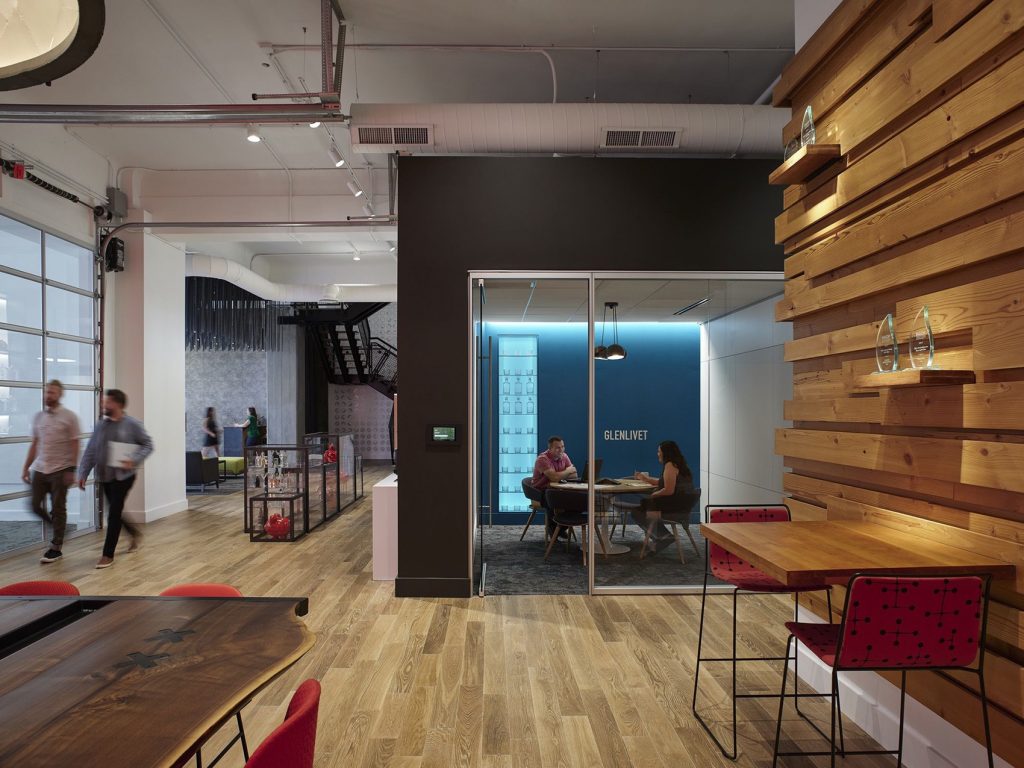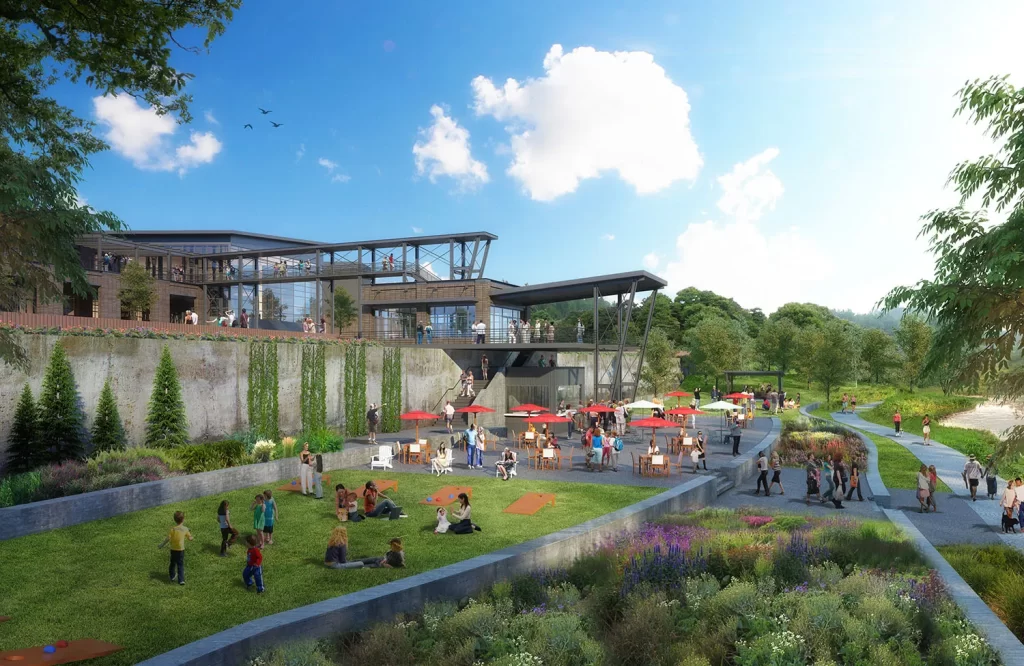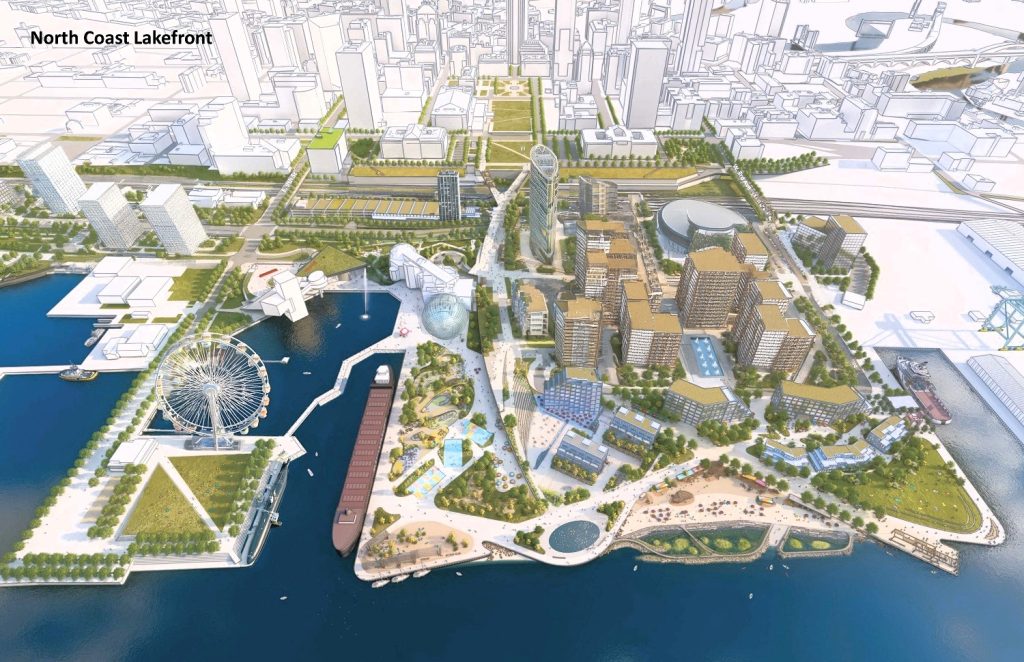
Downtown Cleveland’s lakefront will be much more vibrant and publicly accessible year-round without the massive Huntington Bank Field blocking its use to the public on the public’s schedule. This unofficial rendering also assumes that Burke Lakefront Airport would be closed so that high-rise structures could be built on or near the lakefront (Ardoonave). CLICK IMAGES TO ENLARGE THEM.
I-X Center events, stadium reuse to lift downtown
A COMMENTARY
A downtown is a horrible place for a National Football League (NFL) stadium. It’s why half of the 32 NFL teams don’t play their home games at downtown-based venues. And when the Cleveland Browns leave downtown for suburban Brook Park, it will be Downtown Cleveland that gains the most from their move, not Brook Park. The reasons for this are many.
For the record, I don’t care where the Browns go as long as it’s not Downtown Cleveland. Thankfully, even before the Browns leave, Cleveland city officials have hedged against their departure by recently making a brilliant move to support the repurposing of at least 1 million square feet of the International Exhibition (I-X) Center into a new use, reportedly a data center.
Only 400,000 square feet of the I-X Center is available to host shows. The rest is subleased by Industrial Realty Group LLC (IRG) to warehouse users or is vacant. IRG will repurpose the remaining exhibition space in that 2.2-million-square-foot facility with a needed use and an investment that will create a small amount of new jobs.
And, starting next year, it will effectively force all of the I-X Center’s shows, exhibitions and other large-space events to relocate downtown to the Huntington Convention Center of Cleveland. It’s the only exhibition facility in Greater Cleveland with enough floor space to accommodate these events.
The newly expanded downtown convention center has 550,000 square feet of event and meeting space. This includes 225,000 square feet of exhibit hall space, plus two large ballrooms totaling 52,200 square feet and meeting rooms. Nothing else is planned in Greater Cleveland that would come anywhere close to its floor space.
The convention center could grow even larger depending on what happens to the neighboring Justice Center site. Cuyahoga County is taking its sweet time in deciding which new Consolidated Courthouse proposal and if the current Justice Center site will be repurposed to a new use.
Or, the convention center could be expanded with an enclosed pedestrian concourse and multimodal transportation center across the lakefront railroad tracks to new convention facilities, hotels and restaurants where Huntington Bank Field now sits.
Ex I-X shows
Even if there is no expansion of the convention center, downtown wins by closing the I-X Center to shows.
Multiple sources have different annual attendance figures for the I-X Center, as the I-X Center doesn’t report them. But those attendance estimates range from 1.5 million to 2 million people. That’s spread among two dozen events per year.
Each of those events are typically held over multiple days. For example, and according to the Greater Cleveland Automobile Dealers’ Association, the 2024 Cleveland Auto Show at the I-X Center drew 129,000 people over 10 days. Relocated, that’s a nice steady source of business for downtown’s hospitality economy and it doesn’t require a huge amount of parking because the attendance is spread out over time.
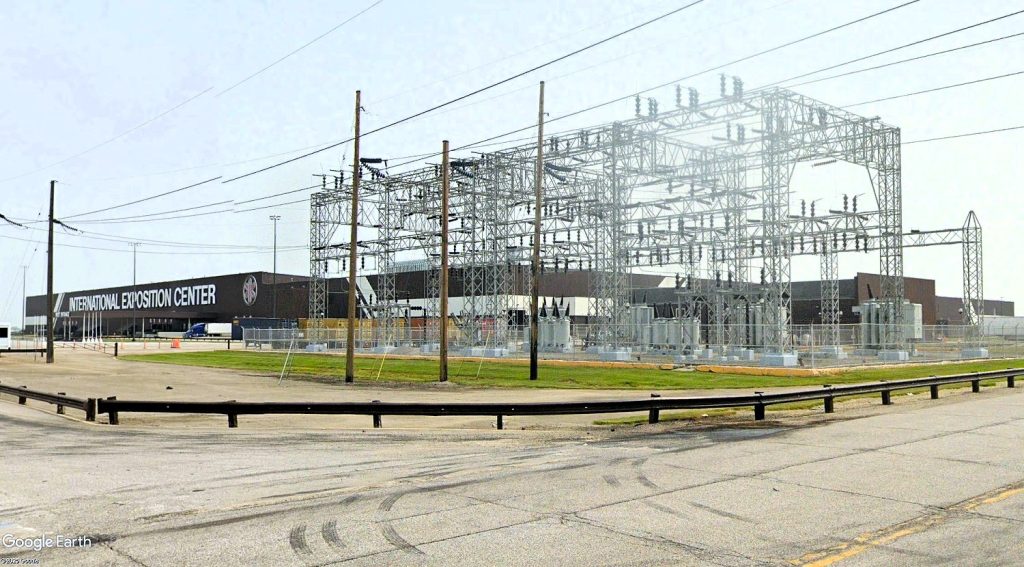
This is what makes the I-X Center attractive as a data center — power. This 25-megawatt substation has enough electricity to support a 1-million-square-foot data center. The I-X Center has 1.5 million square feet of available space after exhibitions are pushed out, likely to the Huntington Convention Center of Cleveland (Google).
By comparison, the 67,431-seat Huntington Bank Field is only half as busy as the low-range attendance for the I-X Center. In 2024, the stadium hosted 13 events with a total attendance of 831,751 people, according to the NFL and event promoters. And last year was a relatively good year for that huge facility dominating our community’s lakefront.
Its 2024 events included eight regular-season Browns games, two preseason games, a Rolling Stones concert, a combined Billy Joel and Rod Stewart concert and WWE’s SummerSlam which drew a record-breaking crowd.
The stadium was quiet for the remaining 352 days of 2024. It will have a similar run this year and probably every year until it is demolished, possibly in 2030. And when it is, that’s when those of us who cheer for downtown should cheer for the stadium’s demolition. The reason is simple.
Parking bomb
Every time Huntington Bank Field hosts a major event, it sets off a parking bomb downtown. Acres of prime real estate near our otherwise beautiful Great Lake are left barren, windswept and lifeless as a result. Nothing grows except stormwater runoff. They sit there silent for weeks and sometimes months at a time until the next parking bomb goes off.
As opposed to the car-centric suburbs where people put on their cars each morning, cars and parking restrain the potential of downtowns. Walking, biking, transit and the mixed-use density they foster and sustain are what make downtowns vibrant.
Some of the most highly regarded downtowns — New York, Los Angeles, San Francisco Bay Area, Boston, Washington and Seattle — have 40-55 percent of their residents working downtown. Most, like Cleveland’s, fall in the 10-20 percent range. To boost that here, the stadium and its parking need to go away.
Consider that 1 acre of surface parking lot can accommodate 100-150 cars. Or, if developed with residential buildings averaging five stories tall, with one-third of land area set aside for streets, sidewalks and other public spaces, it can accommodate 230 residents and at least 5,000 square feet of commercial/retail/restaurants.
If developed with 10-story residential buildings, that 1 acre can accommodate 500 residents and 12,000 square feet of commercial space. At at an average of 15 stories, this jumps to 800 residents and 20,000 square feet of commercial uses on that 1 acre. That’s activity, vibrancy, occupancy and humanity every day, 365 days per year. Not a dozen days per year as Huntington Bank Field has been used.
And that’s just one given acre in the parking hinterland surrounding the Browns’ home venue. The city’s 30-year stadium lease with the team, expiring after the 2028 football season, requires a minimum number of spaces near North Coast Harbor.
That lease could not be located. However, in offering to extend that lease, the city pledged 3,700 exclusive parking spaces to the Browns plus another 12,650 parking spaces within a 10-minute walk of the stadium.
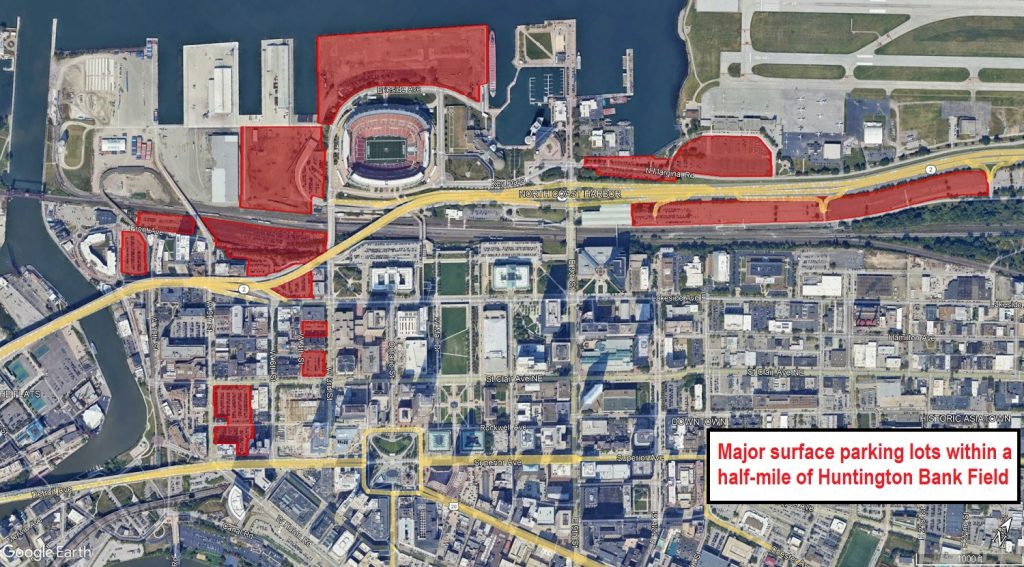
Eighty acres of surface parking lots are shown here in red within a half-mile of Huntington Bank Field. Most are empty except for stadium events. Adding the stadium itself, 100 acres of downtown land becomes more valuable as development sites than they do for parking if the stadium goes away (Google).
There are 80 acres of surface parking lots within a half-mile of our lakefront and its stadium, according to Google Earth. This doesn’t include parking garages like the Huntington Park/Convention Center Garage or the Willard Park/City Hall Garage. But it does include the North Coast Lot (Muni Lot), the eastern end of which extends 1 mile from the stadium.
Downtown’s residential market, aka Cuyahoga County’s fastest growing residential market for 20 years, is on a collision course with that parking requirement. Something’s gotta give.
11 million trips
Then we have the site of the stadium itself. Huntington Bank Field is set on 20 acres of land, including its pedestrian plazas and grassy areas surrounding it. Except for the dozen days a year it is used, it is a black hole. And the Haslam Sports Group decides when it is used as they have control over the scheduling of events there.
In other words, the Haslam Sports Group controls when and how you can use 20 acres of our precious downtown lakefront that is owned by the city — ie: you, the taxpayers. On three sides of this property, the city has planned a publicly accessible North Coast Harbor for everyone. But the center of it is off limits for more than 350 days per year.
It’s why the stadium must go. If replaced by land uses we can enjoy, including residential with a block of units set aside as affordable, it will be of far great use to the community. And it will be of far greater benefit, providing new tax revenues to support more services citywide. We almost had a similar opportunity before.
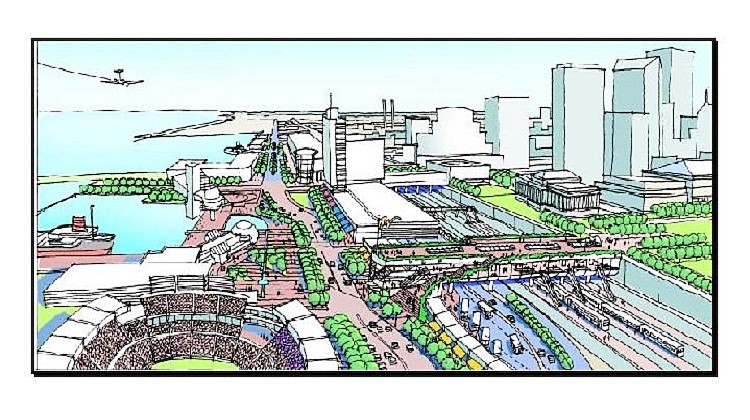
Shortly before the Cleveland Browns returned in 1999, Parsons Brinckerhoff (now WSP USA) developed this plan for extending the convention center as an enclosed concourse with a public rooftop and a multimodal transportation center inside. Also shown is the Shoreway-turned-boulevard which City Council voted for in 2024 (WSP).
Many forget the city’s previous administration, led by Mayor Frank Jackson, awarded development rights 11 years ago to 20-plus acres of land north of the stadium to Cumberland TCC, LLC, a partnership between Trammell Crow and Cumberland Development. It proposed 1,000 residential units, 80,000 square feet of office space, and 50,000 square feet of retail/restaurant space.
Instead, the Jackson administration did an about-face and handed the development rights to the Haslams which planned an even larger lakefront development around a renovated stadium.
When Mayor Justin Bibb was elected, his administration created a lakefront redevelopment masterplan focused on public spaces, recreation and equity. The Haslams wanted their stadium-area development. They found a 176-acre canvas in Brook Park where not only they could own the land (the stadium-area land fill recovered from a Great Lake cannot be privately owned), but it was solid land on which a heavier domed stadium could be built.
With the lakefront stadium gone, it can host a 20-acre center of development for a reimagined downtown lakefront. But I would set aside 1.8 acres for a public field that’s approximately the same dimensions and location as the football field that’s been at this site for nearly a century. Another 4.8 acres of land would be for streets, sidewalks and other public spaces.
If the remaining 13.4 acres is redeveloped with mixed-use structures averaging five stories in height, that’s nearly 3 million square feet of new development. Given market conditions, the development would be residential-heavy, but would have commercial uses as well — office, retail and restaurants.
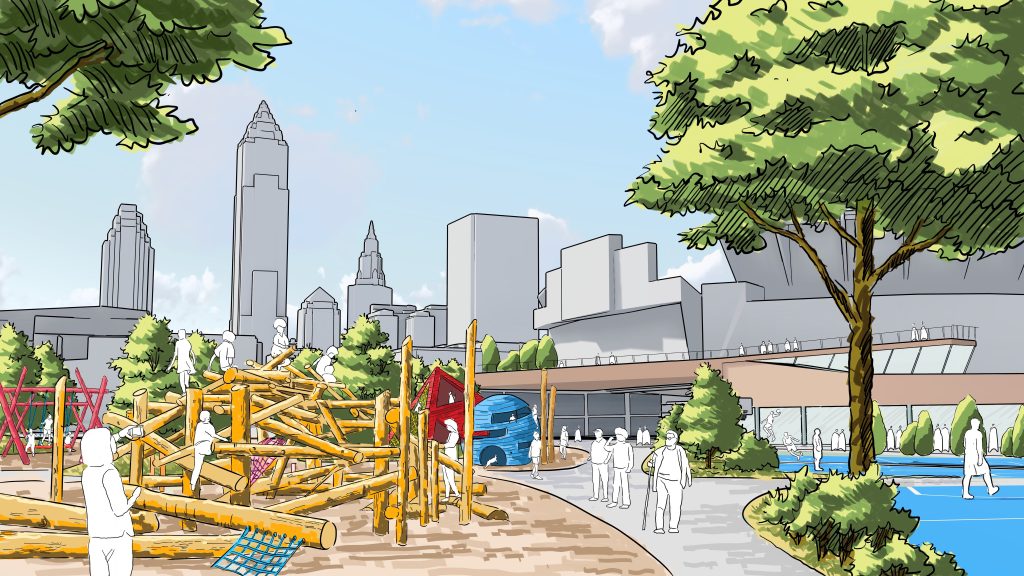
The city’s lakefront masterplan was approved in 2023 while keeping Huntington Bank Field in it as a placeholder in the absence of a finalized outcome for it. The city asked its lakefront planning consulting team to develop concepts for the stadium site in the event the Cleveland Browns leave for Brook Park. No plans have been publicly released (FO).
In addition, it could have expanded convention facilities. And/or it could have an aquarium. And the historic football field park would be large enough to host both American football and world football games and practices with a few thousand seats around it.
Point is, there’s enough land here where a variety of uses could be accommodated that, in total, would draw much more activity year-round than Huntington Bank Field does. How much more? Consider that a typical residential unit generates four trips per day. And one thousand square feet of office typically generates 2.63 vehicle trips per day. Restaurants and retail generate even more.
Over an entire year, a redeveloped lakefront stadium site could generate 11 million trips compared to the 1,663,502 trips to and from Huntington Bank Field. Add to that the redevelopment opportunities that await on the 80 acres of parking lots nearby. That’s built on the basic foundation of I-X Center’s shows relocated to Downtown Cleveland.
Total all of that up and a conclusion is inescapable — it’s a shame the Haslam Sports Group didn’t think about leaving downtown sooner.
END

